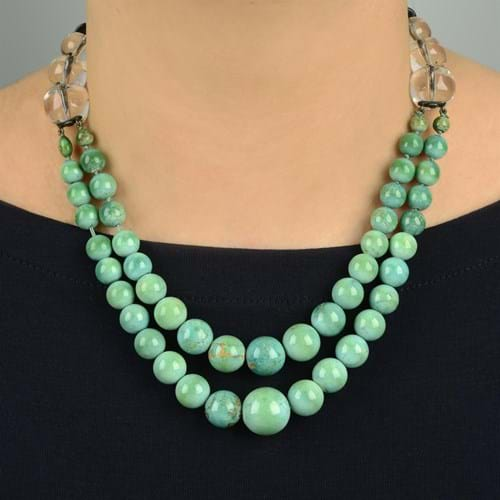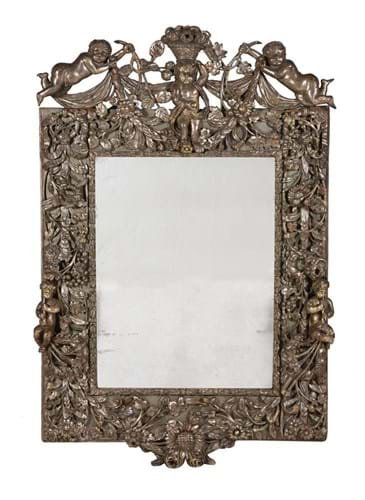1. René Boivin necklace – £32,000
This Art Deco turquoise, rock crystal and black enamelled silver necklace, above, sold by Fellows in Birmingham on May 26, carries the maker’s mark of the celebrated French atelier René Boivin (1864-1917).
Boivin himself died in the Great War years but the studio he founded with his wife Jeanne (1871-1959) created some of Paris’ most celebrated and influential jewellery for more than eight decades. Jeanne Boivin became renowned for championing female designers including her daughter Germaine Boivin, ‘little Suzanne’ Belperron (who worked at Boivin from 1921-32) and Juliette Moutard (from 1931-54).
Unstable economics in the period of the 1930s-40s encouraged creativity and innovation in the use of semi-precious stones. This particular design – very much in the manner of Belperron – is known in a number of different materials.
A similar necklace with a gold half loop sold for $50,000 at Sotheby's New York in April 2014, another bringing €17,000 at Christie’s Paris in 2010. Both were dated to c.1950.
Fellows’ necklace, guided at a modest £2000-3000, raced away to bring £32,000.
2. Arts and Crafts mirror – £2100
This Scottish Arts and Crafts brass framed mirror is the epitome of the so-called Glasgow Style. Closer inspection reveals the initials MV for Marion Henderson Wilson (1869-1956), the ‘Glasow Girl’ who studied at the Glasgow School of Art from 1884 to 1896 and excelled in the production of repousse metalwork.
She was a regular exhibitor at the Glasgow Society Lady Artists’ Club.
The mirror, measuring 16 x 11in (41 x 28cm) and in very good condition sold way over hopes to bring £2100 (estimate £100-150) at Thomas Callan in Ayr on May 27.
3. Staffordshire Protestant martyrs figure group – £2200
As a hotbed of non-conformism and temperance, the Staffordshire potters created an unusually large number of figures celebrating key figures in the history of the Protestant religion from influential preachers and clerics to celebrated theologians.
One particularly rare group of Victorian figures, in the manner of the Burslem potter Thomas Parr, remember some of the Protestant martyrs burnt at the stake during the reign of Mary I.
Two of these were among the best-performing lots of the Harry Ryans (1927-2021) collection of Staffordshire portrait and animal groups offered by Kinghams in Moreton in Marsh on May 27-28. They are not for the feint hearted.
Made around 1860, a group of bishops Ridley and Latimer standing back-to-back in a burning pyre carried the title and inscription: Be of good comfort, Master Ridley, and play the man: we shall this day light such a candle, by God's grace, in England, as, I trust, shall never be put out.
Similarly, a figure of Archbishop Thomas Cranmer modelled in a gesture of prayer as the flames lick his white robe was inscribed Burned at Oxford, March 21, 1556.
Estimated at £100-150 apiece, they sold on account of their rarity for £2200 each.
The son of a Yorkshire coal miner, Harry Ryans never lost his accent despite living in London for over 60 years. After a brief teaching career, he began trading on Portobello Road, specialising in Victorian-era Staffordshire pottery and paintings on glass, and later moving first to Richmond, then to South Kensington.
4. View of the Golden Temple – £400,000
The India in Art sale at Bonhams on June 7 was topped by this textbook Orientalist work by Edwin Lord Weeks (1849-1903).
The American visited the Golden Temple at Amritsar on at least one of his expeditions to India, the best documented of which was in 1893. He later wrote: ‘The Golden Temple gives one the impression of a glittering jewel, or of some rare old Byzantine casket wrought in enamel and studded with gems. It has at first sight a glamour of unreality, like an opium vision of De Quincey, or the pleasure dome of Kubla Khan’.
Weeks painted the subject on several occasions in a number of formats. This relatively small work measuring an accessible 20in x 2ft 6in (51 x 76cm) appears to be contemporary with a monumental painting measuring over 10ft (3m) wide taken from the same perspective.
Offered with a guide of £100,000-150,000, it did rather better, bringing £400,000.
5. William and Mary mirror – £80,000
The furniture sale at Dreweatts in Newbury on May 30-31 – an event viewed at Kirtlington, Oxfordshire – was topped by this 5ft 2in (1.64m) high William and Mary carved and silvered wall mirror. Estimated at £6000-8000, it sold at £80,000.
It was part of a consignment from the late Catherine Mary ‘Kate’ Wass (1942-2021), a direct descendant of one of William IV’s 10 illegitimate children with the actress Dorothea Jordan (1765-1837). She had inherited the 31 lots from her maternal great uncle, Standish Robert Vereker, 7th Viscount Gort (1888-1975) whose country estate was Hamsterley Hall in Rowlands Gill, County Durham.
Hamsterley Hall, an 18th century manor house with later gothic revival revisions and once owned by the comic novelist Robert Smith Surtees (1806-64), came by marriage to the Viscounts Gort in 1885.
The 7th Viscount was the family’s most important connoisseur. His acquisitions included, in 1948, a Boulle cabinet-on-stand that is now in the Getty.
A March 1940 Country Life article on the mansion titled The Role of Antiques Today: Furniture and Tapestry at Hamsterley Hall featured several interior shots with some of the objects offered for sale at Dreweatts clearly in situ. This mirror with its scrolled foliage and putti may be the example photographed in a bedroom.
Dated to c.1680-90, it is closely related to one in the Victoria & Albert Museum that retains its original silver leaf over gesso gilding, bearing the arms of Sir Henry Gough (1650-1724) of Old Fallings Hall, Staffordshire. The silvering would have given the mirror the appearance of solid metal.
Dreweatts said there was some losses and restorations to the carving with the mirror plate and old replacement.










